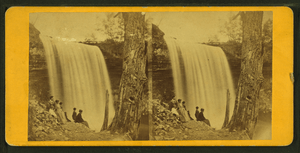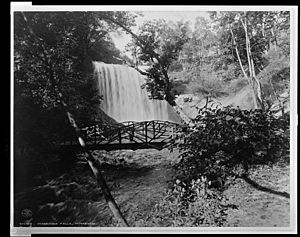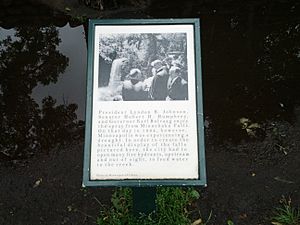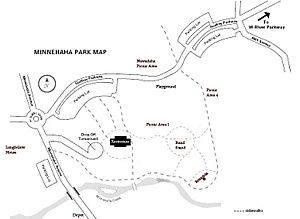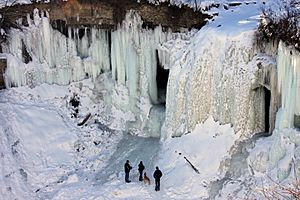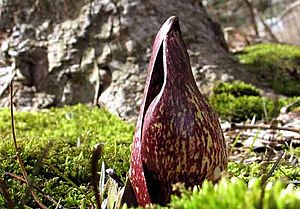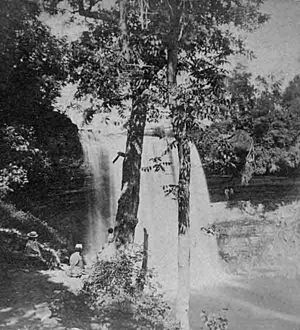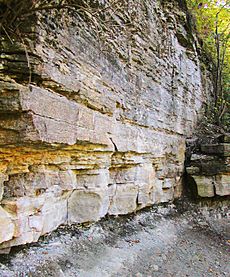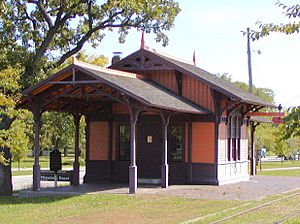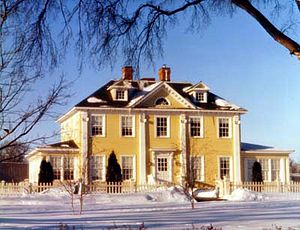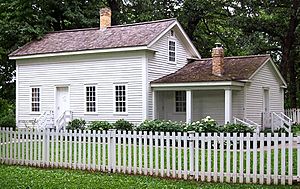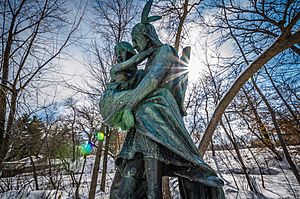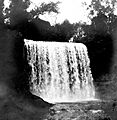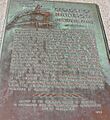Minnehaha Park (Minneapolis) facts for kids
Quick facts for kids |
|
|
Minnehaha Historic District
|
|
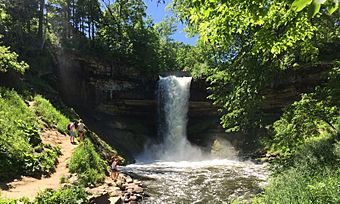
Minnehaha Falls, June 2017
|
|
| Location | Minneapolis, Minnesota, United States |
|---|---|
| Area | 170 acres (69 ha) |
| Built | 1849 |
| Architect | H.W.S. Cleveland; Et al. |
| Architectural style | Greek Revival, Late Victorian, Georgian |
| NRHP reference No. | 69000369 |
| Added to NRHP | November 25, 1969 |
Minnehaha Park is a famous city park in Minneapolis, Minnesota, United States. It is home to the beautiful Minnehaha Falls and the lower parts of Minnehaha Creek. The park is officially called Minnehaha Regional Park and is managed by the Minneapolis Park and Recreation Board. It is also part of the Mississippi National River and Recreation Area, which is a unit of the National Park Service.
A landscape architect named Horace W.S. Cleveland designed the park in 1883. It became part of the Grand Rounds Scenic Byway system. In the 1800s, it was a popular stop on steamboat tours of the Upper Mississippi River.
The park protects important historical places. These sites show how people traveled, how pioneers lived, and different building styles. Some old buildings you can see include the Minnehaha Princess Station, a train station from the 1870s. There is also the John H. Stevens House, built in 1849. This house was moved to the park in 1896 with the help of horses and 10,000 school children! The Longfellow House in the park looks like the home of the famous poet Henry Wadsworth Longfellow in Massachusetts.
Minnehaha Park was added to the National Register of Historic Places in 1969. It is known as the Minnehaha Historic District because of its importance in architecture, business, nature protection, literature, transportation, and city planning.
The main attraction of the park is Minnehaha Falls. Many early photographers loved to take pictures of it. The first known photo was a daguerreotype by Alexander Hesler in 1852. Even though he never visited the park, Henry Wadsworth Longfellow made the waterfall famous with his poem, The Song of Hiawatha. The falls are on Minnehaha Creek, close to where it meets the Mississippi River near Fort Snelling. Over 850,000 people visit Minnehaha Falls every year. It is still the most photographed place in Minnesota.
Contents
Exploring the Park's Past: A Journey Through Time
How Minnehaha Park Began: Early Settlements
The story of this area began in 1805. The U.S. Army bought a large piece of land from the native Sioux people. This land was where the Mississippi and Minnesota Rivers meet. Fort Snelling was built on a bluff overlooking these rivers. Colonel Josiah Snelling oversaw its construction between 1820 and 1824.
In 1821, Josiah Snelling's son, William Joseph Snelling, came to the fort. He explored the creek that feeds Minnehaha Falls. He was with Joseph R. Brown, a local frontiersman. Both were just 17 years old at the time.
What's in a Name? The History of Minnehaha
Some old records call the falls "Brown's Falls." This made some people think they were named after Joseph R. Brown. However, a park ranger named Kathy Swenson researched this in 2009. She found that the name "Brown's Falls" likely came from Jacob Brown. He was a major general and army commander from 1814 to 1828.
The current name, Minnehaha, comes from the Dakota language. It means "curling water" or "waterfall." The Dakota people called Minnehaha Creek "Wakpa Cistinna," meaning "Little River."
The Poem That Made the Falls Famous
The name "Minnehaha Falls" was commonly used by 1855. That year, Henry Wadsworth Longfellow published The Song of Hiawatha. This poem made the falls known all over the world. Longfellow's long poem tells the story of Hiawatha, a Native American hero. He falls in love with Minnehaha, a Native American woman.
Longfellow never actually visited the falls himself. He was inspired by writings from Mary H. Eastman and Henry Rowe Schoolcraft. He also saw a daguerreotype (an early photograph) of the falls by Alexander Hesler. This image, taken in 1852, helped him choose the name for Hiawatha's love.
The "Fashionable Tour": Early Tourism

Starting in 1828, steamboats began traveling the Mississippi River. They went as far north as St. Paul. This was the farthest commercial boats could go. Tourists soon became interested in these steamboat trips. In 1835, the famous artist George Catlin took a steamboat trip up the Mississippi. He was impressed by the scenery. Catlin suggested a "Fashionable Tour" of the upper Mississippi. He said it was a great trip, especially for ladies, because it was easy to access.
After Catlin's visit, more and more tourists came each year. Artists and photographers also visited. Hundreds of Stereoscopic View cards of the falls were made. Most visitors were men, but some women made the journey too. One notable visitor was 80-year-old Elizabeth Schuyler Hamilton, the widow of Alexander Hamilton.
The beauty of the area was also shared through "moving panoramas." These were like early travel documentaries. They showed long paintings that unrolled to tell a story. People would gather to watch these "travel movies" of the 1840s and 1850s. They could "tour" the great river without leaving their cities. Longfellow himself said, "The river comes to me instead of my going to the river," after seeing one.
By the late 1860s, railroads reached Minneapolis and St. Paul. They started advertising Minnesota as a tourist spot. An 1878 travel guide from the Chicago, Burlington & Quincy railway praised Minnesota's beauty. It said the air was "invigorating" and full of "oxygen and ozone." It promised tourists rest and enjoyment, and health for those who were sick.
The guide described a carriage ride from Minneapolis to Minnehaha Falls. It was a pleasant four-mile drive. The round trip fare from St. Louis to Minneapolis was $30. It included Pullman sleeping cars.
The Grand Rounds: A Vision for Parks
In 1883, the state legislature created the Minneapolis Board of Park Commissioners. This was good news for future generations. The board hired a talented landscape architect, Horace Cleveland. Cleveland was a preservationist. He wanted to protect natural landscapes. He used existing features like hills and plants to keep his designs looking natural.
Cleveland designed a system of parks and parkways that connected natural areas. This vision led to the famous "Grand Rounds." It is a series of interconnected parkways and parks centered on the Mississippi River. Later, this vision grew to include a series of lakes, called the "Chain of Lakes." It also followed Minnehaha Creek to Minnehaha Falls. In 1998, the area was named a National Scenic Byway. Today, the Minneapolis Grand Rounds is known as one of the best urban park systems in the world.
Building Minnehaha Park: From Past to Present
Minneapolis' Park Board bought Minnehaha Falls and the land around it in 1889. It became one of the first state parks in the United States. Only New York had created a state park by then. The next summer, the Park Board added tables, seats, and restrooms. By 1893, a pavilion was built. They also approved funding for two "rustic" bridges, one above the falls and one below.
In 1905, a refectory (a place to buy food) was built. It served "clean and wholesome" refreshments at fair prices. In 1926, the park became a center for winter sports. They planned a ski jump and bought toboggans for rent. Major improvements were made from 1936 to 1942 by federal Works Progress Administration (WPA) crews. They built retaining walls, bridges, and stairs.
In 1964, Lyndon B. Johnson and Minnesota Senator Hubert H. Humphrey visited the park. Johnson later won the presidential election with Humphrey as his running mate. Their visit is remembered with a plaque. It tells a funny story: during their visit, Minneapolis was in a drought. To make the falls look beautiful for the photo, the city had to open many fire hydrants upstream!
The park faced a challenge in the 1960s. The highway department planned to build a freeway over Minnehaha Creek. The park board fought this plan and took the case to the U.S. Supreme Court. Luckily, a similar case was decided in favor of protecting park land. This set a rule, and the freeway was never built over the creek. Later, in the late 1990s, a highway was built through a tunnel under a "land bridge." A new area, the Longfellow Garden, was created on top of this land bridge.
Many improvements were also made in the 1990s. The Pergola Garden was created with native wildflowers and grasses. The old parking lot near the falls was removed and replaced with a garden. A new river overlook and a children's playground were added in 2007.
In 2011, major restoration work was finished. Old retaining walls were fixed, and eroded stream banks were restored. Natural seating areas were added, and trails were improved. Invasive plants were removed and replaced with native plants. These new plants have deep roots that help prevent erosion.
What You Can See and Do at Minnehaha Park
Park Layout and Activities
Minnehaha Park is located along the Mississippi River. It is part of the Minnehaha Historic District. The park is 167 acres and includes Minnehaha Creek with its famous falls and glen. It has two main parts: an upper section above the falls, which has open grassy areas like other city parks. The lower 54-acre section is mostly left in its natural state. The creek flows through the upper part, then drops at the falls, and continues through the lower glen for about three-quarters of a mile.
Minnehaha Park is a popular place for weddings and cultural events. Minnesota has many Swedish immigrants. Since 1934, Swedes have celebrated Svenskarnas Dag (Swedish Heritage Day) at the park every June. The park has a bandstand with free music concerts in the summer.
Bicyclists can use miles of off-street trails. One trail leads to Fort Snelling State Park. You can rent bikes, and there is an off-leash dog park area. The park also has picnic sites you can reserve, picnic shelters for groups, playgrounds, and a summer wading pool for children. In winter, the falls freeze, making the park a popular year-round attraction.
Past Attractions: Zoo and Auto Camp
The park once had a zoo and pony rides. In 1893, the Park Board allowed a Shetland pony concession. They also started accepting animals for a zoo. By 1899, the zoo had a bear pit and an alligator tank. The zoo was very popular, but when Theodore Wirth became the new park superintendent in 1906, he had it removed. The animals were given to Longfellow Gardens. However, a fenced area with deer and elk stayed until 1923. This area is sometimes still called "the deer pen."
Between the 1930s and 1950s, there was also an "Auto Tourist Camp." Many tourists stayed there in tents or small cabins. This camp was for the many people traveling the country in their new cars. At one time, there were also several grist mills on Minnehaha Creek. You can still see the remains of a stone and earth mill dam, built in 1853 or 1854, next to the creek.
Plants and Animals of the Park
Gardens in the upper park include Longfellow Gardens, Minnehaha Falls Pergola Garden, and the Song of Hiawatha Garden. The lower glen has many trees native to Minnesota. These include basswood, black ash, maples, oaks, willows, and cottonwoods.
You might find unusual plants like skunk cabbage. This plant blooms very early in spring, even when it's freezing or snowing. It has a strong, unpleasant smell, but insects that like rotting smells are attracted to it. Skunk cabbage can make its own heat, keeping the inside of its flower 15–35 degrees warmer than the air. This warmth helps attract cold-blooded insects that come out early in spring. Later, its large leaves grow, but they die back by mid-August.
Other wildflowers you might see include wild ginger, trout lilies, anemones, marsh marigolds, and various ferns and sedges. The Minneapolis Park and Recreation Board works to remove plants that don't belong there. This helps native plants survive and grow.
Minnehaha Falls: A Natural Wonder
The main feature of the park is Minnehaha Falls. It is located several thousand feet upstream from where it originally met the Mississippi River. That was about 10,000 years ago, at the end of the last Great Ice Age. The erosion below the falls shows Minnesota's geological past. You can see layers of rock from over 450 million years ago, when Minnesota was covered by shallow seas.
Minnehaha Falls is connected to Saint Anthony Falls. St. Anthony Falls is the only waterfall on the Mississippi River. About 10,000 years ago, St. Anthony Falls was several miles downstream. Over time, the water wore away the soft sandstone layer under the harder limestone. This caused the falls to move upstream about 4 feet (1.2 m) each year. As St. Anthony Falls moved past Minnehaha Creek, a second waterfall, Minnehaha Falls, was created. It also moved upstream to its current spot in the park.
Old photos from the 1800s show the waterfall was much wider, like a curtain. Today, it's narrower. If there was enough interest and money, the falls could be restored to their 19th-century look.
In winter, the falls freeze into a dramatic ice cascade. This can last well into spring. If there isn't much rain in the autumn, the falls might almost dry up. In summer, especially in rainy months like June and July, the water flow can be very strong.
In June 2014, a professional kayaker named Hunt Jennings kayaked down the waterfall. The water was very high due to heavy rains. He only got a small cut on his lip. However, park officials were very worried. They said that the drop, the large rocks, and the strong current could easily hurt or kill someone. They warned others not to try it.
Park Geology: A Look at Earth's History
When you walk from the falls down to the Mississippi River, you can see Minnesota's ancient geological history. The top layers of soil and gravel were left by the most recent Ice Age, about 10,000 years ago.
At the upper falls, you are standing on the Platteville Limestone Formation. This rock was formed during the Ordovician Period, about 450 million years ago. Back then, North America was near the equator, and a warm, shallow sea covered much of Minnesota. There was lots of sea life. You can find many marine fossils in the limestone and shale in the park. These fossils include corals, bryozoans, brachiopods, clams, snails, cephalopods, and trilobites.
As you go down to the base of the falls, you pass through the Platteville Limestone and a thin layer of Glenwood Shale. At the base, you enter the Saint Peter Sandstone Formation. This is a very pure white quartz sandstone. It's famous worldwide for being a very clean, well-rounded sand. This sand was first deposited as beach sand along the shores of the Ordovician sea.
Closer to the Mississippi River, you might see the Glenwood Shale Formation. This thin layer of gray-green rock was likely formed in deeper water offshore. These three rock layers show how the sea level rose during the Ordovician period.
Historical Buildings: Stepping Back in Time
Minnehaha Depot: A Historic Train Station
The Minnehaha Depot, also known as "the Princess Depot," is a small train station built around 1875. It was a stop on the Milwaukee Road railroad. This made it easy for people to get to the park from Fort Snelling and Minneapolis. The depot handled up to 39 train trips a day! Inside, it is well-preserved. You can see an iron heating stove, waiting room benches, and a ticket window.
In 1964, the depot was given to the Minnesota Historical Society. The Minnesota Transportation Museum helped restore the building. Today, they help explain its history. The depot is open in the summer on Sundays. The 50th Street / Minnehaha Park light rail station of the METRO Blue Line now serves the park.
Longfellow House: A Poet's Inspiration
Despite its name, the Longfellow House was never home to the poet Henry Wadsworth Longfellow. It was the home of Robert F. Jones, a Minneapolis businessman. Built in 1907, the house was designed to look like Longfellow's home in Cambridge, Massachusetts. It was part of Jones' private botanical garden and zoo near Minnehaha Falls.
After Jones died, the house fell into disrepair. His will gave the property to the city. The city used the house as part of the Minneapolis public library from 1936 to 1967. The house was moved in 1994 and fixed up. It opened as an information center in 2001. Today, it is home to a botanical art school and offices for the Minneapolis Parks Foundation. The Longfellow House and John H. Stevens House also offer historic nature walks around the park.
John H. Stevens House: The Birthplace of Minneapolis
The John Harrington Stevens House was built in 1849 or 1850 near St. Anthony Falls. It was moved to Minnehaha Park in 1896. This house is special because it was the first wood-frame house built west of the Mississippi River. John H. Stevens was allowed to build his house on land controlled by Fort Snelling. In return, he provided ferry service across the Mississippi River.
His home became a center for community and social events. It is called the "Birthplace of Minneapolis." Both Hennepin County and Minneapolis were organized in Stevens' home. The name Minneapolis was even suggested there.
In 1896, over 10,000 school children helped pull the house to its current spot in Minnehaha Park. The children were divided into seven teams. Each team had about 1,000 students. As teams finished their part, they got on trolley cars to go to the park. The house traveled four miles and arrived at the park at 3 p.m. that day. In the evening, there were fireworks and the falls were lit up.
Statues and Sculptures: Art in the Park
The park has several statues. One is a bronze sculpture called Hiawatha and Minnehaha by Jacob Fjelde. It shows Hiawatha carrying Minnehaha. It was first made in plaster in 1893 and then cast in bronze and placed in the park in 1912.
Other statues honor important people. There is a statue of John H. Stevens. He was the first person allowed to live on the west bank of the Mississippi River in what became Minneapolis. A statue of Swedish musician and poet Gunnar Wennerberg was placed in the park in 1915. A mask of Dakota leader Taoyateduta (Little Crow) was placed overlooking the falls in 1992.
Images for kids
-
Hiawatha and Minnehaha sculpture by Jacob Fjelde
-
Taoyateduta, known as Chief Little Crow



